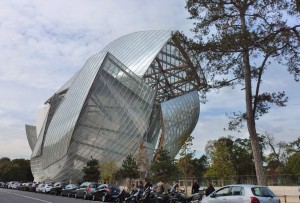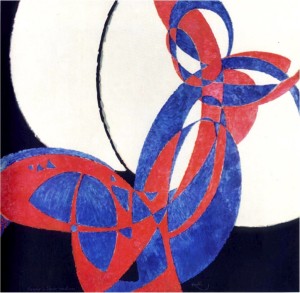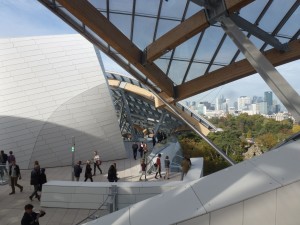
Louis Vuitton Foundation Building
In the Bois de Boulogne at the edge of Paris, the latest building by Frank Gehry (architect of the Dancing House on the Prague riverbank) arouses interest, displeasure, admiration, envy, and many interesting questions…
When Bernard Arnault, the owner of LVMH Group (and the richest entrepreneur in France) visited a museum in Spanish Bilbao 15 years ago, it immediately became clear to him that Frank Gehry would be the right architect to design a foundation and museum of contemporary art in Paris in the park Bois de Boulogne. Ghery is an eccentric architect and the 1989 winner of the Pritzker Architecture Prize. The LVMH group has owned the license for the 20 hectare Bois de Boulogne since the 1980´s, thanks to the acquisition of the famous Christian Dior house, which owned the land since the end of the 1950´s when it was bought by Marcel Boussac, the important French entrepreneur and founder of Parfum Christian Dior.
Designed by Alphand and Barrel-Deschamps, and deeply connected with Paris symbolism, the landscape park inspired Gehry from the very beginning. The foundation project was an ideal opportunity to revive the original spirit of the place, and to enhance the overall feel of the garden. The walks were redrawn, architectural elements were cultivated, and various new plants now contribute to the vegetation. The main building stands 40 meters high, and not only sensitively harmonizes with the surrounding elements, but evokes the 19th century history of the garden’s glass architecture. Visitors experience many visual surprises, beginning with the sudden emergence of the building among the 100 year old oak and beech trees. An airy feeling surrounds the facade from all sides, enchanting this relatively small building made from steel, concrete, and wooden fibers, all “wrapped” in 12 glass sails that seem to triple the overall size. From the front, the building seems to be sailing on water. The engineers were able to project the 12 giant sails thanks to a highly sophisticated and complicated production technology, and by assembling a monumental puzzle consisting of 3600 glass panels. A special, enormous oven was built to produce the slender glass tables that required a certain level of flection, flexibility, and strength to withstand atmospheric conditions. The total weight of the steel structure is 15,000 tons, which is twice as much as the Eiffel Tower.
Within the total area of 11,000 m², including 7,000 m² of public space, the building’s 4 levels offer 11 galleries devoted to presenting the foundation´s art collections and short-term exhibitions. A glass-walled auditorium, with fantastic acoustics and a flexible design, can hold between 360-1000 people. Furthermore, there is a restaurant, as well as numerous viewing terraces which are intended to create the impression of a labyrinth, so that visitors are constantly surprised by new perceptions, sights, and feelings. It is a paradox that among the real functions of the building, there are amazing terrace views in all directions, overlooking Paris, La Defense, and Bois de Boulogne.

František Kupka Amorpha Fugue in two colors
In the building’s construction and functionality, careful regard was given to the highest standards of environmental sustainability. Rainwater, primarily used for cleaning the facades and windows, is collected in a system that is separate from the drinking water, where it is filtered. There is a distribution system that waters the green areas and terraces. The consumption of drinking water is regulated to prevent waste. And perhaps the most interesting feature is the building’s use of geothermal energy, warming and cooling the interior using natural and renewable resources. The building boasts an especially suitable geographic location, with two sources of ground water under the building. With a constant temperature of about 13 °C, water is pumped via closed circuit through a heat exchanger which, depending on the situation, cools or warms secondary circuits that regulate the temperature of the floors. After the thermal transfer, the water returns back to its original place without being consumed.
The original estimated cost of construction in the amount of 100 million EUR was increased to a total budget of 500 million EUR, which eventually was exceeded as well, though the final cost was never made public. This does not contradict the city’s interests, however, since the foundation was completely financed by the LVMH company and Bernard Arnault.

View from the terrace of the Foundation
A third inaugural exhibition of the foundation is now showing works of art from the first half of the 20th century, which laid the foundations for today’s modern artists. Many masterpieces have been borrowed from numerous world collections, and include artists such as Matisse, Malevitch, Munch, Bacon, Giacometti, Mondrian, Delaunay, Brancusi, Rothko, Monet, and Picasso. The selection and presentation of two big canvases by František Kupka shows the importance of this Czech artist, while his canvas “Amorpha, Fugue of Two Colors” expresses an abstract vision and interpretation of music. This painting maintains an irreplaceable role in art history, as it was the first non-figural painting publicly presented at the Salon d´automnev exhibition in Paris, 1912.
The goal of The Louis Vuitton Foundation is to achieve the highest level of standards set by the International Council of Museums, and to prove that Louis Vuitton is more than just a lifestyle brand. It wishes to remain a non-profit institution, serving society and the general public. At the same time it hopes to preserve and exhibit the tangible and intangible heritage of mankind, to further education, and give pleasure to all visitors. With The Louis Vuitton Foundation, Paris is getting an unconditional guarantee not only for a new art center, but also another symbol in the city’s history of great architecture.
Author and photo: Ing. Arch. Iva Drebitko

